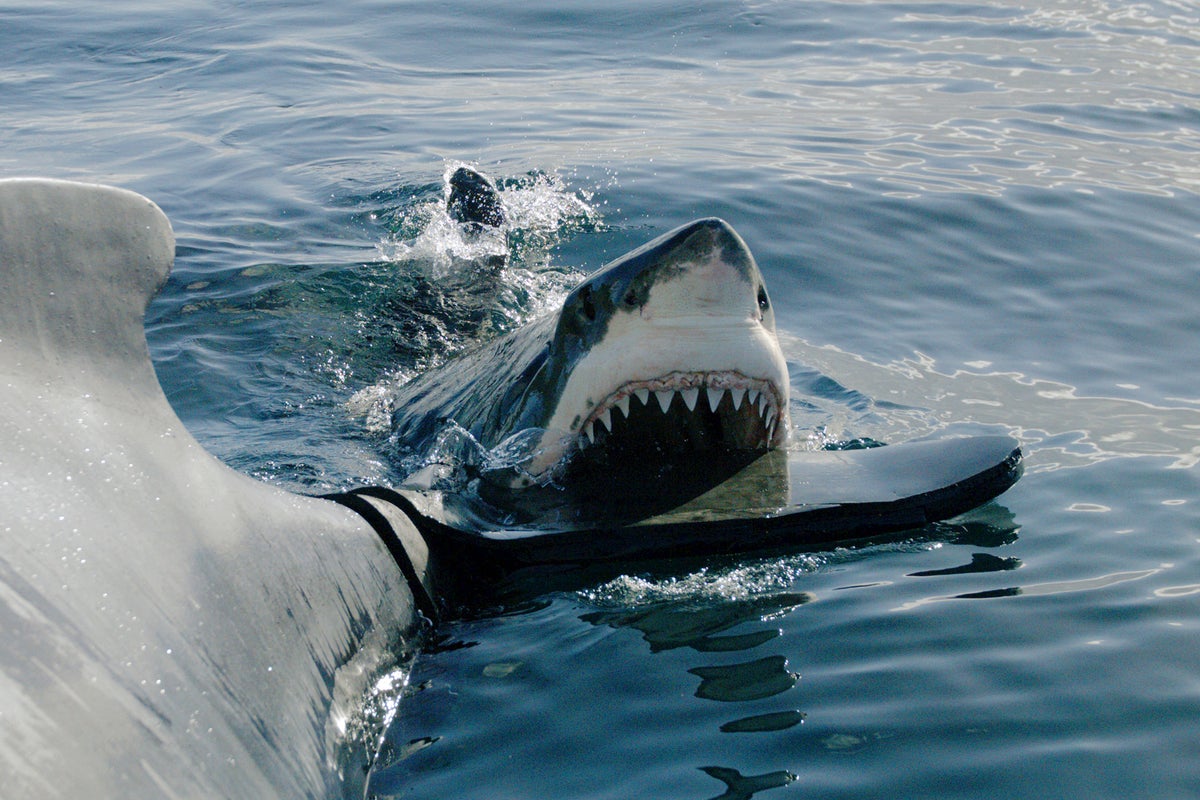
Support truly
independent journalism
Imagine stepping into a life-sized whale carcass decoy and steering it into deep water. You're looking — yes, looking — for a group of hungry sharks to spark a feeding frenzy. To attract them, you shoot out hundreds of gallons of synthetic blood and chum. Then watch them lose it.
That's what marine biologist Liv Dixon did for Discovery Channel's “Shark Week,” one of several eye-popping moments during the 21 hours of new programing this year where scientists risk everything to understand the apex predators better.
“Sharks jump at every opportunity,” Dixon says. “And I’m kind of the same. I’m going to jump at every opportunity I get. You feel the adrenaline running through your veins like your whole body is shaking.”
The week kicks off Sunday with Dixon's hour-long “Belly of the Beast: Bigger & Bloodier,” in which she and veteran “Shark Week” biologist Dr. Austin Gallagher try to lure a so-called Queen Boss off the New Zealand coast.
“We’re seeing these kind of subgroups or clans of white sharks, and we think they might be dominated by a larger female that we’ve termed the Queen Boss, which I love — big female energy coming in here,” says Dixon. “We really just want to tap into the social dynamics of these sharks.”
The seven nights of new shows are hosted by John Cena and include scientists traveling to Australia to see why there’s been an uptick in attacks near Sydney Harbor, and to Mexico to figure out why there have been three fatal Great White shark incursions near a fishing village.
The show “Big Shark Energy” has researchers comparing some New Zealand sharks’ speed, hunting ability and fearlessness to determine who has the swagger to swim away with a female shark, while other scientists hope to locate the fattest Great White — is 6,000 pounds possible? — and look at their poop to figure out what they’re eating.
“Shark Week” has become a key part of the summer holiday TV schedule, a place where humans safe on land can see ancient apex predators effortlessly and unnervingly slip into view from the dark and snap open their jaws.
“They just seem still oddly like a monster species from the past,” says Howard Lee, the president of Discovery Networks and TLC. “There’s always something new to learn that has not yet been discovered. There’s even breeds of sharks that we have not always captured.”
“Shark Week” highlights also include a look at whether angel sharks remain in Japan’s waters — including remarkable footage of the birth of velvet dogfish shark pups — and why a South Pacific resort has become a shark attack hotspot with bull, tiger and Great White sharks moving closer and closer to the beaches.
As always, there is a deep respect for the creatures and strong science beneath the amusing titles, dramatic music and racy titles like “The Real Sharkano” and “Monster Hammerheads: Species X.”
The big female energy that Dixon mentioned is apparent out of the water, too. She and researchers like Zandi Ndhlovu, Christine de Silva and Kendyl Berna are front and center, challenging the male-dominated shark waters.
“I hope more than anything it can inspire other young women and females to get involved,” says Dixon. “I’m so proud to represent women in this space. I really think that’s important for other women, and especially the next generation of young entrepreneurs and scientists.”
Ndhlovu, a South African-based freediving instructor and founder of The Black Mermaid Foundation, first appeared on “Shark Week” in 2022 and returns for two episodes this season, blazing a way forward in representation.
“It’s amazing to be working with sharks and showing up in the world as a Black woman in a way that allows little kids to see that the ocean belongs to them, too — increasing that representation around who the explorers and what science means.”
The week also sees an investigation into a massive mako dubbed “Makozilla,” accused of chomping on sea lions off the California coast. Scientists use a sea lion decoy and then drop huge slabs of tuna to try at get bite marks to match with sea lion scar attacks.
“I personally also do whale research and I’m like, ‘I wish there was a ’Whale Week,' but no one would be like, ‘Oh, wow, these humpbacks are really peaceful and beautiful,'” says Berna, an environmental scientist and wildlife filmmaker, who spent time in a shark cage luring makos.
“My hope is that it gets little kids to love sharks as well,” she adds. “And hopefully, by the time my kids are watching things like this, we’re going further in the direction of beginning to create more protections for sharks, not just in the U.S., but really globally.”
Discovery’s “Shark Week” has a rival — its programming coincides with National Geographic’s “SharkFest,” which also has hours of sharky content, including Anthony Mackie exploration of the shark ecosystem in his hometown of New Orleans. There's also an unconnected shark thriller in movie theaters called “The Last Breath.”
“Shark Week” — with an accompanying podcast this year — was born as a counterpoint for those who developed a fear of sharks after seeing “Jaws.” It has emerged as a destination for scientists eager to protect an animal older than trees.
“Isn’t that one of the things that makes the ocean so incredible? And isn’t that what makes life so amazing?” asks Ndhlovu. “We know so much on land. We don’t know so much about the ocean, and there’s so much to still be discovered.”







